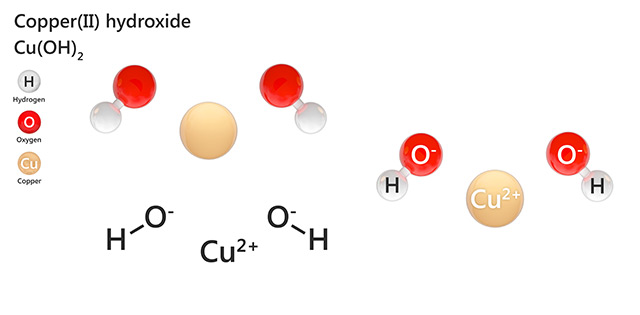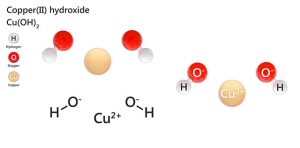
Copper hydroxide — toxicity, side effects, diseases and environmental impacts
Thursday, December 21, 2017 by Frances Bloomfield
http://www.naturalpedia.com/copper-hydroxide-toxicity-side-effects-diseases-and-environmental-impacts.html

Copper (II) hydroxide is the hydroxide of copper, a malleable, reddish-orange metal. This material typically appears a pale-blue solid or powder. Synthetically producing copper (II) hydroxide usually involves mixing a sodium hydroxide with a dilute solution of copper (II) sulfate; another method makes use of electrolyzing water.
According to the Pesticide Properties Database, copper (II) hydroxide is a “widely used copper fungicide” that has been approved for use against fungal and bacterial diseases in various countries.
List of known side effects
Swallowing copper (II) hydroxide is very dangerous as it can lead to copper compound poisoning, the symptoms of which are:
- Anemia
- Burning in the chest and abdomen
- Diarrhea
- Headaches
- Intense nausea
- Metallic taste
- Shock
- Sweating
- Vomiting
In more severe cases, the affected individual or individuals can excrete black or tarry stools, expunge vomit with blood, or become jaundiced. If vomiting doesn’t occur following ingestion, then systemic poisoning can happen, which in turn can lead to kidney and liver damage, widespread capillary damage, or even death.
Although its designation as a respiratory irritant is debated on, the inhalation of copper (II) hydroxide can lead to health complications, regardless. Breathing in the fumes or dust of this material can lead to headaches and cold sweats, while prolonged exposure can result in respiratory discomfort or distress.
Direct contact with copper (II) hydroxide can be just as dangerous. Ocular contact can result in eye irritation, eye damage, conjunctivitis, or even corneal ulcerations and turbidity. Dermal contact, on the other hand, can induce skin irritation or inflammation. Skin with cuts, abrasions, or lesions are at high risk of producing systemic injuries, as these can serve as entry routes for copper (II) hydroxide to infiltrate the bloodstream.
Body systems affected by copper (II) hydroxide
Ingesting copper (II) hydroxide can lead to the stomach retaining and absorbing this material. This can result in toxic injuries across numerous organs and organ systems, primarily:
- blood;
- brain;
- capillaries;
- gastrointestinal lining;
- kidneys; and
- liver.
Inhaling copper (II) hydroxide can damage the respiratory system. Long-term exposure of large amounts of this material can impair lung function and increase the risk of respiratory conditions like pneumoconiosis, a lung disease brought about by breathing in dust particles. Moreover, copper (II) hydroxide can exacerbate pre-existing respiratory conditions and disease, namely chronic bronchitis or emphysema, a long-term lung disease characterized by the shortness of breath.
Furthermore, certain rare hereditary conditions (e.g. Wilson disease) can cause the body to accumulate copper on exposure. If action is taken to prevent or remedy this, then this can bring about irreversible liver, kidney, bone, vision, or central nervous system damage.
Items that can contain copper (II) hydroxide
As a fungicide, copper (II) hydroxide has been used on:
- Almonds
- Apples
- Beans
- Blackberries
- Broccoli
- Cantaloupes
- Cauliflowers
- Eggplants
- Lettuce
- Mango
- Onions
- Peaches
- Pears
- Peppers
- Plums
- Sugar beets
- Walnuts
How to avoid copper (II) hydroxide
Those who are most at risk of copper (II) hydroxide exposure or contact are those who play a role in the handling of this material. As such, they should follow a number of steps and recommendations to minimize exposure:
- For storage: Keep copper (II) hydroxide in its original container and store it in a cool, dry, well-ventilated area away from foodstuff containers and incompatible materials.
- For handling: Avoid drinking, eating, or smoking while in close proximity to copper (II) hydroxide.
- For personal protection: Opt for chemical-resistant gloves, PVC aprons, and overalls. Avoid wearing contact lenses as they can absorb this material and concentrate them on the eye. Have barrier cream and skin-cleansing cream on hand at all times. Ensure that the immediate work area is equipped with eye wash units and emergency showers in the event that exposure occurs.
- For spillage: Small spills should be cleaned up immediately using dry clean up procedures to reduce dust generation. Major spills are moderate hazards that are best cleaned up through the dry or wet method. Emergency responders should be alerted immediately and given the location and nature of the spill.
Where to learn more
Summary
Exposure or contact with copper (II) hydroxide can cause a wide array of health problems. For example, ingesting this material can cause nausea, vomiting, and diarrhea, and can damage the liver, kidneys, and gastrointestinal lining. On the other hand, inhaling copper (II) hydroxide can impair the function of the lungs and aggravate the symptoms of any pre-existing lung conditions. Moreover, copper (II) hydroxide can irritate or damage the skin and eyes.
Sources include:
Sitem.Herts.AC.uk
PMEP.CCE.Cornell.edu
PesticideInfo.org
Datasheets.SCBT.com
Tagged Under: Tags: Copper (II) hydroxide






